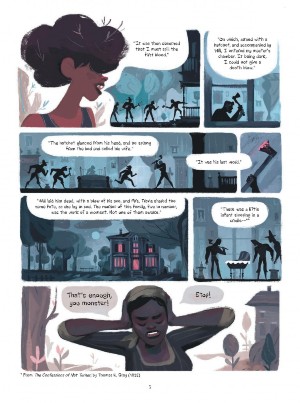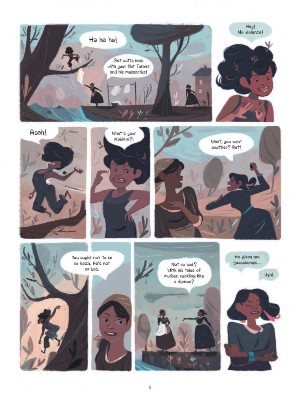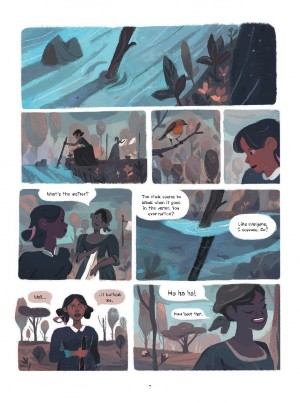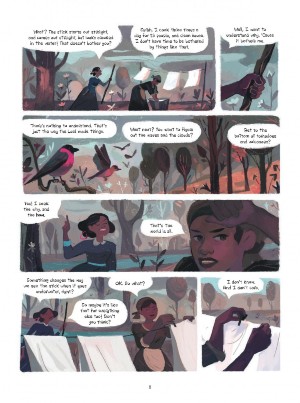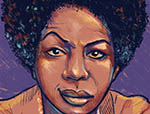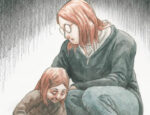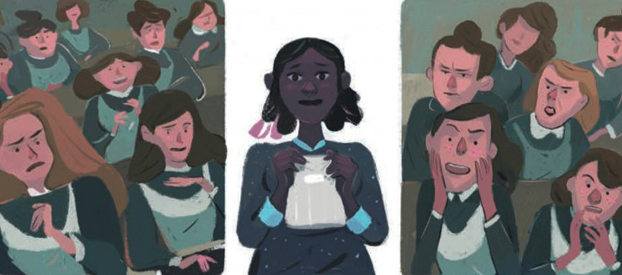
White All Around, translated by Montana Kane from Blanc autour, the bande dessinée by Wilfrid Lupano and Stéphane Fert, tells the important story of the Canterbury Female Boarding School – a institution that sought to open up education for young women of colour in the “free” Connecticut of the 1830s, leading to predictable results but a proud legacy. And, as the struggle to access education continues to this day, it’s a compelling story that has lost none of its resonance.
The driving force behind the school was its principal, Prudence Crandall, was inspired by the intellectual curiosity of a local African-American girl, Sarah Harris (“I seek the why and the how”), who turned up at the school one day to find out why a stick appears ‘bent’ when it’s stood in water.
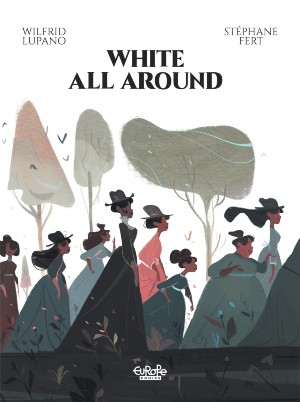 After prompting disquiet among the local white community by inviting Sarah to join the school, Crandall then put a notice in an underground abolitionist paper, The Liberator, that her school would be opened “for the reception of young ladies and little misses of colour”. And after that she went even further, announcing that the school would be purely for black students. Which, even in a state where slavery had been abolished, went down just about as well as you’d imagine.
After prompting disquiet among the local white community by inviting Sarah to join the school, Crandall then put a notice in an underground abolitionist paper, The Liberator, that her school would be opened “for the reception of young ladies and little misses of colour”. And after that she went even further, announcing that the school would be purely for black students. Which, even in a state where slavery had been abolished, went down just about as well as you’d imagine.
As the school grew, so did resentment among the local white folk. Meanwhile, the establishment waged “lawfare” on the school, leading to the arrest and detention of its principal. At the harrowing climax of the book, Miss Crandall’s legal triumph is the spark that ignites a blaze of mob violence that brings down the curtain on her ambitious venture.
With the school’s principal absent for much of the book, the focus shifts to the varied and vividly drawn characters of the girls themselves. And their education isn’t confined to the classroom. With their mentor in prison, the girls meet Miriam – a “witch” – in the local woods. She alerts them to the power of the feminine and the potential that they carry: “We bring children into the world and raise them. Educated black women will have educated black children, whose children will be even more educated.“ One of the students even takes a more radical pagan turn, feeling the power of a Goddess who is also a woman of colour.
Their awareness is also raised by ‘Feral’, a young African-American man who lives wild and regales the girls with blood-curdling tales of a recent slave revolt in the south. As he points out, even the education Miss Crandall offers provides a purely white view of the world. As the voice of a nascent black consciousness, he sneers, “Get your fill of the white world. You’ll still be black when you’re done.”
While this is a deeply relevant and enthralling book, there’s something about its execution that doesn’t quite click. There’s often a dissonance between the story and the artwork; the latter’s picture-book grace takes some of the rough edges off a story that is as upsetting as it is inspiring. The sneering racists of Canterbury CT are depicted as pantomime grotesques rather than the people we pass on the street every day. In a way, this ironically ‘others’ them and allows the book’s white readers to skip any whiff of complicity with the assurance that “they’re not like us”.
Possibly the most powerful bit of the book is the backmatter by Joanie DiMartino, the curator of the Prudence Crandall Museum (the site of the school, now a National Historic Landmark). In it, DiMartino traces out – as far as possible – the later lives of some of the young women who attended the school, and the heroic part some of them played in the subsequent abolition of slavery and the early struggle for civil rights.
Fifty-three years after Prudence Crandall opened her school, the Connecticut state legislature recognised her achievement and granted her a pension. However, her legacy had a longer tail, influencing later cases in the US Supreme Court that culminated in Brown v Board of Education of Topeka (1954), the landmark case in which segregation in public schools was declared unconstitutional.
The struggle for girls’ education in particular is, sadly, one that’s going to be fought for a while to come: according to UNICEF, 132 million girls are currently out of school around the world. That equates to about one girl in five, with a series of damaging consequences for individuals, communities and society as a whole. And that is why, despite its imperfections, White All Around is a book that needs to be read.
Wilfrid Lupano (W), Stéphane Fert (A), Montana Kane (Tr), Cromatik Ltd (L) • Europe Comics, €7.49 (digital only)
Review by Tom Murphy
For more information or to support the ongoing campaign for girls’ education, please visit the Malala Fund and CAMFED





